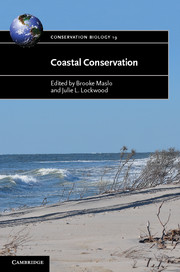Book contents
- Frontmatter
- Dedication
- Contents
- List of contributors
- List of abbreviations
- 1 The conservation of coastal biodiversity
- Part I Biodiversity Status of Coastal Habitats
- 2 Global patterns of mangrove extinction risk: implications for ecosystem services and biodiversity loss
- 3 Open-coast sandy beaches and coastal dunes
- 4 Biodiversity, ecosystem services, and the conservation of seagrass meadows
- 5 Cascading effects of global oyster reef loss on the health of estuaries
- 6 Biodiversity status of coastal dune forests in South Africa
- 7 The distribution and conservation of birds of coastal salt marshes
- Part II Emerging Threats
- Part III Synthesis
- Index
- Plate section
- References
5 - Cascading effects of global oyster reef loss on the health of estuaries
Published online by Cambridge University Press: 05 June 2014
- Frontmatter
- Dedication
- Contents
- List of contributors
- List of abbreviations
- 1 The conservation of coastal biodiversity
- Part I Biodiversity Status of Coastal Habitats
- 2 Global patterns of mangrove extinction risk: implications for ecosystem services and biodiversity loss
- 3 Open-coast sandy beaches and coastal dunes
- 4 Biodiversity, ecosystem services, and the conservation of seagrass meadows
- 5 Cascading effects of global oyster reef loss on the health of estuaries
- 6 Biodiversity status of coastal dune forests in South Africa
- 7 The distribution and conservation of birds of coastal salt marshes
- Part II Emerging Threats
- Part III Synthesis
- Index
- Plate section
- References
Summary
Estuarine health and biodiversity
Estuaries are transition ecotones where freshwater from the land drains into the sea. Classically defined as semi-enclosed coastal bodies of water with a connection to the open sea and within which seawater is measurably diluted with freshwater derived from land drainage (Pritchard, 1967), estuaries are characterized by a continuous exchange of tidal flows that create a marked salinity gradient from the limnetic zone (where the river enters the estuary) to the mouth of the estuary (Venice System, 1959). Estuarine habitat types include shallow open water, mudflats, fresh- and saltwater marshes, oyster reefs, seagrass beds, mangrove forests, and river deltas (Davis & Fitzgerald, 2004). Complex patterns of sedimentation, water circulation, geomorphology, and energetics make estuaries some of the most productive ecosystems in the world (Kennish, 2002).
Due to their tremendous habitat diversity, estuaries support a broad array of both resident and transient organisms, with taxonomic groups ranging from benthic meiofauna and macrophytes to wading birds and large cetaceans. This biodiversity, in turn, promotes proper estuarine functioning and the provisioning of ecosystem goods and services (Barbier et al., 2011). Healthy estuaries support the persistence of commercial fisheries, provide nursery habitats for many commercially and ecologically important species, and maintain water quality through filtration and detoxification mechanisms (Granek et al., 2010). Therefore, they are of high economic and ecological importance. However, the continued viability and health of estuarine systems rely heavily on multiple complex interactions between various trophic levels and abiotic factors, held in a delicate balance that maintains the integrity of the system.
- Type
- Chapter
- Information
- Coastal Conservation , pp. 131 - 160Publisher: Cambridge University PressPrint publication year: 2014
References
- 2
- Cited by

